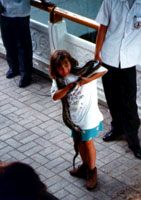|
Maybe you remember those early behavior studies from the 1950s where a researcher wiggled a rubber hose along the floor of a monkey cage--monkeys that had been raised in captivity and had never seen a snake.
And lo and behold, these primates go into a climbing frenzy, screeching and howling and trying to squeeze out the top of their cages like botulism tomatoes. And thus it was proved that there's much more to our natural fear of snakes than Johnnie teasing Suzie, Freudian foolishness, or those ghastly 1950s 3-D jungle movie matinees.
The snake is a powerful symbol. Our earliest archeological remnants found in the Mediterranean and Japan are of an earth/snake mother. The hood of the cobra protected the Buddha, while the rattler fought the eagle in Aztec images and on Mexican flags and attempted to scare off the British on our early American flags.
In fact, one of the few images more powerful than the symbol of the snake is a real one, a great big killer one, free and slithering only a few feet from you. So powerful, in fact, that we quickly get in touch with our primate roots and scoot to the top of our cages.
Which is what happens daily at the demonstration in the Bangkok Snake Farm.
|
|
|
|
Located in downtown Bangkok, adjacent to the university and attached to the Queen Saovabha Memorial Institute was the second snake farm in the world (the first was built in Sao Paulo, Brazil). Opened in 1923, the facility is part of the Thai Red Cross Society. Its purpose is to create a steady and valuable source of snake vaccines and sera.
Southeast Asia has many deadly snakes. These include the King Cobra, several types of spitting cobra, at least two varieties of deadly but usually passive sea snakes, Banded Kraits, Russell's Viper, Malayan Pit Viper, Green Pit Viper and the aggressive problem child of the group, the Siamese Cobra. Over 2,500 deaths a year are attributed to snake bites in Southeast Asia.
The Bangkok Snake Farm was developed to raise many of these deadly vipers and routinely harvest their venom. The "milked" venom is then injected in horses and after a period of time small amounts of the horse blood is collected and treated to produce appropriate anti-snake bite medicines.
Entering off the bustling streets of Bangkok, you walk into a quiet, shaded area. An entry fee is collected to help offset the costs. Once inside you wander around large cages, collections of every one of the deadlies to be found, if you're so unlucky, throughout the region.
Twice a day an informative slide show is given, including valuable advice on how to avoid bites and what to do if bitten. And then the show begins. Visitors sit in a rows of cement pews, separated from the central stage by only a three foot wall and their blind confidence. Like most things in Asia, it's a personal injury lawyer's dream come true.
|
|
 Cassidy was the first to rush to center stage to hold the sweet tempered python Cassidy was the first to rush to center stage to hold the sweet tempered python
|
|
The handlers begin reaching into small enclosures around the walled inner court yard, sometimes using snake sticks and sometimes using only their hands and quick reflexes. Out by the tail comes a dozen of your worst nightmares--and nightmares with a real attitude. One of the handlers hauls out three sizable Banded Kraits. They coil around his arms and get in a spat with each other while he wonders what's on the dinner table at home. Another handler teases three Siamese cobras into hissing and jabbing and showing off their eyeglass tactoos and sociopathic upbringings.
But the show stopper is, of course, the King Cobra. This handler hauls out this beast, considered by many herpetologists as the most intelligent of all snakes. This is a snake that eats other snakes for lunch, as well as breakfast, dinner and in-between snacks. And this one's over 15 feet long and as thick as a race car's tailpipe. And as soon as he hits the floor he rears, standing nearly four feet (remember that wall between us and the snake, the wall that's only three feet?). It parries and fakes with a grace that even Ali in his prime would have coveted.
|
|
|
A few of the more stupid in our crowd of 30 visitors have moved out of their seats and down to the floor for a better view and photo prospect. And while I was busy trying to focus my camera this noble beast decides it's time to go for a walk, or rather a fast slither, in my direction. I missed the shot, as well as sixteen heartbeats. But I wasn't alone. Our whole group found the way to the top of our individual cages where we screeched and howled and proved the theory of genetically encoded memories.
And while we were making fools of ourselves and stepping stones of each other, the handler simply reached down and yanked that cobra back to his place by his tail, deftly grabbed its head, and began to milk the snake of a surprising amount of amber venom. A deadly poison that in the alchemy of the Institute would be converted into a life-saving medicine.
|
|